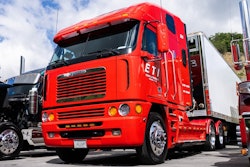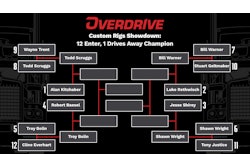Flatbed drivers are always ready to step up to the challenge.
When it comes to pulling a flatbed, personal accountability for the cargo takes on a new meaning. From the moment the load is placed on a flatdeck to the time it comes off hundreds or thousands of miles later, the driver assumes the liability for keeping it secured to the wagon.
“Flatbedding takes a lot more responsibility than pulling a van,” says owner-operator Dave Wadsworth of Lolo, Mont., a veteran flatbedder. “Because of the strapping and tarping, it’s hard work, but I enjoy the hell out of it.”
Not only is flatbed trucking physically demanding, it also requires a high level of attentiveness. A driver doesn’t have the luxury of closing up the doors and knowing the load is contained for the remainder of the trip. It’s not the easiest way to make a living in trucking, but for devoted flatbed drivers, it’s a source of pride.
The challenge
Flatbed trucking encompasses a huge array of freight, basically anything that doesn’t have to be refrigerated, won’t fit into a dry van or can’t be poured into a tanker. Lumber, pipes, steel coils, machinery – the list is endless. Sometimes the cargo conforms nicely to the deck, but often it is multi-dimensional or over-dimensional. It’s this kind of diversity of cargo that makes flatbedding appealing to a certain class of drivers.

“I like the challenge,” says Willard Allen of Circleville, Ohio. The 61-year-old driver has been pulling a flatbed for PFT Roberson for 16 years, logging more than 1 million safe-driving miles. “I enjoy not knowing what I’m going to be doing the next day. Every day is different.”
Veteran flatdeck driver John B. Young Jr. of Clinton, S.C., agrees wholeheartedly. “The work is interesting because you haul all kinds of freight,” says the 52-year-old company driver, who works for Senn Freight Lines out of Newberry, S.C.
Drivers often chuckle when asked about unusual loads. Freight such as statues, pizza ovens, used portable toilets, trees, honey bees, airplane engines and missiles become the usual when you’ve been flatbedding for several years. “I’ve hauled so many things, it’s hard to say what’s unusual,” says Young, whose father also was a flatbed driver for more than 50 years.
Flatbedding sometimes offers a great range of geographical challenges as well. Former owner-operator Michael Gower of Ayr, Ontario, Canada, was part of a two-truck convoy that transported a radar-tracking device along a winter road to Stony Rapids, Saskatchewan. The 150-mile trip in minus 45-degree temperatures took the trucker-turned-dispatcher more than four and half hours because of the road conditions. “The load was 12 feet wide, 36 feet long and 11 feet high, and it was fully tarped,” the 41-year-old Gower says. “With 22-percent grades in some places, it was pretty scary.”
Many flatbed drivers have tried other types of trucking before discovering flatbedding was their preference and forte. “I didn’t like pulling a van,” says owner-operator Robert Ellinger of Hamilton, Mont. “I don’t like monster warehouses with 50 docks where I have to wait in line to get loaded or unloaded.” The 56-year-old, who is leased to Sammons Trucking, adds that customers are almost always glad to see him. “Most of the time they are waiting to load or unload you,” he says. “Usually you’re the only truck there – at most there may be one or two other trucks.”
Neatly packaged
If you want to get the dander up of a good flatbedder, just mention improperly secured cargo. Leaning loads and straps flopping in the breeze as they travel down the highway are no-nos for experienced flatdeck drivers. “I see too many guys out here today with their loads improperly secured,” Wadsworth says. “To not secure the load properly in the first place or to not care enough to stop and check your load and fix any problems is unprofessional, stupid and lazy.”
Gower attributes some of that to inexperience or carriers not supplying their drivers with
A good flatbed driver takes pride in load securement and how it looks going down the highway.
the proper equipment to secure their loads. “Some guys need better training and better equipment,” he says. “Then again, there are a few that just don’t care. But I believe educating drivers about securement and providing them with good equipment would help a great deal.”
The new load securement regulations that went into effect in January changed the way drivers use cargo securement devices to prevent loads from shifting on or within or falling from a tractor-trailer. In some instances it changed the number of tie downs required to secure certain types of cargo.
While some drivers disagree with parts of the new regs concerning how a load must be strapped, chained or tarped, nearly all are in agreement with the provision of the new law about checking the load during transport. The new regulation requires a driver to inspect cargo and securement devices within the first 50 miles of a trip.
“When I pull flatbeds, I always stop within the first 25 miles to check my load,” says James Spence, a 54-year-old CRST Malone driver from Ball Ground, Ga., who pulls both flatbed and vans. “Nine times out of 10 you’re going to have a loose strap or chain.”
The new regulations also require drivers to inspect their loads every 150 miles and when they change duty status. “I always check my load when I stop to make sure it’s safe to go on with,” Allen says.
One major gripe many flatdeck drivers have with securement regulations concerns how different law enforcement officials interpret the law. “Some times it changes from one side of a state to another,” Wadsworth says. “But if you handle yourself professionally, you learn to do what you need to comply, to keep you from getting a ticket. It can be aggravating, but it’s part of the job. I would like to see more conformity in interpretation, though.”
Aside from the desire not to be fined for a securement violation, seasoned flatbedders feel a high degree of personal responsibility to the motoring public. Losing part of a load on the road can be a deadly sin. Allen says he’s not shy to refuse a load if he thinks it can’t be safely secured. And most feel that if a load is properly secured it shouldn’t move off the trailer deck if a driver has to hit the brakes hard, or even during a minor collision.
“If you think the load needs an additional strap, put it on,” Gower says. “Why wouldn’t you? If you’re working within the window of tolerance, it’s going to get you in trouble. Safety is first.”
Wadsworth says his philosophy is simple. “If I’m hauling steel coils, I don’t want that coil visiting me in the cab if I have to get on the brakes. I don’t want Mom and Pop in a minivan getting hurt either by something coming off my trailer. If I have to lay my truck over to avoid an accident, fine, but my load better be tied to the trailer like I put it there when I crawl out of the truck.”
And a good strapping and tarping job doesn’t go unnoticed. Other truckers will sometimes compliment a flatbedder’s load while it’s going down the road. “You can tell by a guy’s load if he takes pride in what he’s doing,” Ellingter says.
The most welcomed words of praise come from the customers, who often personally ask for a particular driver because of his dedication to securing a load. “I’ve had customers ask for me to haul their loads because they know I’m going to take care of their cargo,” Allen says. “That means a lot to me.”
Because of the multi-dimensional aspect of many flatbed loads, tarping can be a grueling experience. But the challenge also lends itself to personal satisfaction once the job is done. “I loved tarping,” Gower says. “I used to haul a lot of oversize that was big and ugly. I loved taking cargo that was ugly and making it look like something Santa Claus had wrapped up to give you.”
Not for everyone
Because of the physical work involved in flatbedding, all drivers don’t share the passion for it. Securing loads in sweltering humidity and freezing temperatures definitely isn’t a perk. It’s a part of the job. “I think some guys don’t like flatbedding because it’s too much like work,” Allen says. “Flatbedding is a little tougher than some trucking jobs, but I enjoy it.”
Gower said he believes the flatbed segment will grow rapidly in the next several years, and more drivers will be needed. Equipment improvements like roll-type tarping systems will help attract more drivers to flatbedding because they make the job easier.
But as always has been, the biggest draw will be what makes flatbedding unique – a sense of accomplishment for handling whatever freight is placed on the trailer. “It’s a great feeling to know that if it’s something that can be safely put on my truck, I can secure it and haul it,” Young says.








